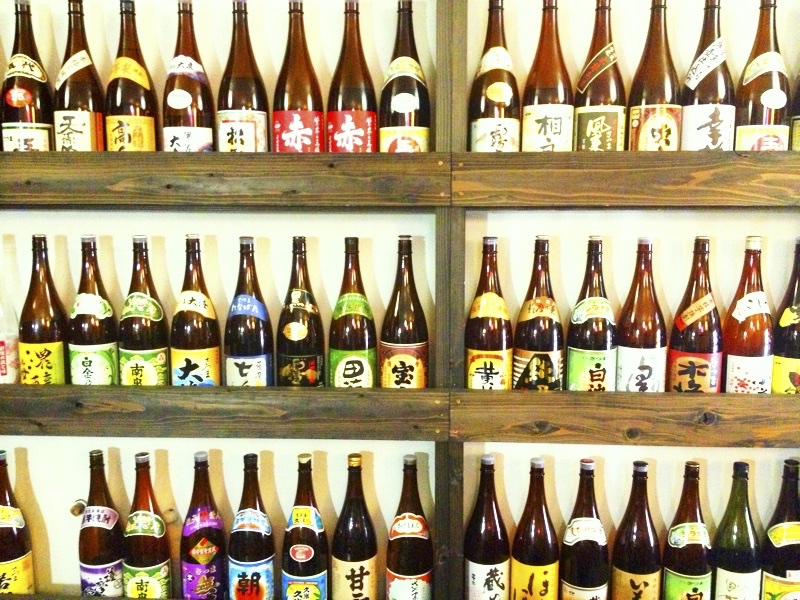10. Takahashi Shuzō (高橋酒造) ¥6.6 billion, Kumamoto
Located in Hitoyoshi in southern Kumamoto Prefecture on the border of Kagoshima and Miyazaki, in the heart of the Kuma Jōchū (球磨焼酎) producing region, Takahashi’s main product is, not surprisingly, kome (rice) jōchū, with Hakutake (白岳) and Hakutake Shiro (白岳白) being their best-selling products.
9. Hombō Shuzō (本坊酒造) ¥7.0 billion, Kagoshima
One of the first of Kagoshima’s shuzō, I believe, to try its hand at the production of “western liquors”, such as whiskey and wine, Hombō of Kagoshima City produces imo jōchū, mugi jōchū, and kome jōchū. Their extensive product line also includes brandy, a very nice gin, and liqueurs.
8. Wakamatsu Shuzō (若松酒造) ¥7.4 billion, Kagoshima
https://www.wakamatsusyuzo.co.jp
Located in the tongue-twisting Ichiki-kushikino-shi (いちき串木野市)[1], Wakamatsu was founded in 1719, making it Kagoshima’s oldest distillery. Main products included Satsuma Ichi (薩摩一) imo jōchū and Sasshū Mugi (薩州麦) mugi jōchū.
7. Satsuma Shuzō (薩摩酒造) ¥10.4 billion, Kagoshima
Founded in 1936, Satsuma is part of the Hombō Group (本坊グループ). It is located in the very southern part of the Satsuma Peninsula in the town of Makurazaki, which is famous for its katsuo-bushi processing plants.[2] The distilleries best-selling products are Satsuma Shiranami (さつま白波) imo jōchū and Kannoko (神の河) mugi jōchū.
6. Hamada Shuzō (濵田酒造) ¥12.9 billion, Kagoshima
https://www.hamadasyuzou.co.jp
Hamada Shuzō, also located in my wife’s birthplace of Ichiki-Kushikino, produces not only imo, mugi and komé jōchū, but also liqueurs and “Japanese spirits” (e.g. gin). They have in recent years also began brewing nihonshu, becoming, I have been told, the first and currently only brewer of saké in Kagoshima Prefecture. Hamada Shuzō’s best-selling brands include Kaito (海童), Kakushi Gura (隠し蔵), Den (伝), and Sekitoba (赤兎馬).
It’s funny, but I didn’t realize until today that Hamada also produces Daimaō (大魔王), which is an imo jōchū that I used to buy as a novelty gift because the celebrated Mao (魔王) was often difficult to find and too expensive when I could Hamada Shuzō also owns Kinzan Gura, located in a mountain setting, where the shōchū is fermented, stored, and aged in the former gold mine. Apparently, my wife’s grandfather worked in that mine for a while.
5. Nikaidō Shuzō (二階堂酒造) ¥15.3 billion, Ōita
Ōita is famous for its mugi (barley) jōchū and Nikaidō is the prefectures second largest distillery. To be quite honest, I am neither a mugi jōchū nor a whiskey drinker, so I can’t quite understand why people can get excited about it. Maybe when I find a brand that knocks my socks off, I will, but as of this writing, I remain unconverted. That said, I will try to give their Kitchomu (吉四六) a try if I ever come by it.
Nikaidō is based in Hiiji Machi (日出町), a small castle town of less than 30,000 just north of Beppu. Neighboring Kitsuki City is worth a visit if you are ever in the area, by the way.
4. Unkai Shuzō (雲海酒造) ¥17.1 billion, Miyazaki
Kagoshima may be famous for its imo jōchū, but Miyazaki is the prefecture that actually produces the most. One reason is Unkai which was founded in 1967 and was the first distillery to produce soba (buckwheat) jōchū in 1973. Originally named Gokase Shuzō, Unkai released Iitomo (いいとも) in 1984. Nine years later, it debuted Japan’s first “zen kōji” soba jōchū.
3. Oenon Group (オエノン・グルップ) ¥40.1 billion, Tōkyō
It appears that if it can get you drunk, Oenon makes it—umeshu, kōrui shōchū, awamori, as well as shōchū made from barley, sweet potato, rice, shiso, kasu (saké lees), seaweed, and, believe it or not, sakura leaves. Now they’ve got my attention.
2. Sanwa Shurui (三和酒類) ¥44.5 billion, Ōita
The mugi (barley) shōchū giant bills its best-selling Iichiko as “The Working Man’s Napoleon” (下町のナポレオン)[3], something that has always made me snigger. Like Kirishima, Iichiko is highly promoted in TV commercials, print media, and in large posters at train stations, featuring a sometimes hard-to-find bottle of Iichiko in a natural setting. Iichiko, itself, is not hard to find at all, as just about any place selling liquor will have bottles of it on its shelves. Personally speaking, the only Iichiko I have ever really liked is their Hita Zen Kōji, but then again I’m not really into mugi jōchū. Sanwa also produces wine, nihonshu (saké), and liqueurs. And while Iichiko is the best-selling brand of shōchū in Japan—7.8 million cases back in 2016—it is third in the world after Korean soju brands Chamisul (Jinro in Japan, 73 million cases sold!) and Chomchorom (31.7 million cases).
1. Kirishima Shuzō (霧島酒造) ¥65.9 billion, Miyazaki
No surprise here. In 2012, Kirishima overtook Sanwa to become Japan’s highest grossing shōchū maker. Interestingly, it was the distillery’s second president who first proposed renaming single-distilled otsurui shōchū (乙類焼酎) “honkaku” shōchū (本格焼酎) back in 1957. (It wasn’t until five years later that the Ministry of Finance officially accepted the new name.) In the “noughties”, Kirishima debuted and then heavily promoted its “Kurokiri” brand which is probably Japan’s best-selling imo jōchū, despite being fairly unremarkable. Let’s just call it “The King of Shōchū”.
[1] Ichiki-Kushikino City (いちき串木野市), pop. less than 30,000, was formed by the merger of two towns in the Hioki District (日置郡) back in 2005. Seems neither town was willing to give up its name, so now we have a name that is hard to say when drunk, a problem because the city is home to half a dozen shōchū distilleries.
[2] Katsuo-bushi, or dried bonito fish flakes, are the chief flavoring ingredient in miso soup. Today, there are about 70 small family businesses in Makurazaki City, working year-round to boil, cut, dry and smoke bonito, the unique odor of which can be smelled across the downtown area.
[3] This is a loose translation. Shitamachi (下町) originally referred to the lower part of Edo (modern-day Tōkyō) where the lower castes (i.e. merchants and artisans) lived as opposed to hilly Yamanote (山の手) where the samurai lived. Shitamachi denotes an area of lower social status.
